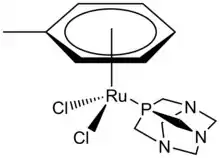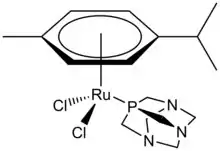RAPTA
RAPTA (ruthenium arene PTA) is a class of experimental cancer drugs. They consist of a central ruthenium(II) atom complexed to an arene group, chlorides, and 1,3,5-triaza-7-phosphaadamantane (PTA) forming an organoruthenium half-sandwich compound. Other related ruthenium anti-cancer drugs include NAMI-A, KP1019 and BOLD-100.
Structure and properties
It is envisaged that RAPTA derivatives have the “piano stool” structure like others organometallic half-sandwich compound.[1] This is observed by the crystal structure of RAPTA-C which exhibits the archetypal half-sandwich structure.[2] The PTA ligand was designed to make the complexes more soluble in water, and the two labile chlorido ligands can exchange to aquo ligand in the presence of water.[3]
Synthesis
In a typical synthesis, [Ru (η6-p-cymene)Cl2] is reacted with 2 equivalents of PTA for 24 hours under reflux in methanol to yield to [Ru(η6-p-cymene)Cl2(pta)].[4]
RAPTA derivatives


Several derivatives of RAPTA were synthesized, and two of the most notable are [Ru(η6-p-cymene)Cl2(pta)] (RATPA-C) and [Ru(η6-toluene)Cl2(pta)] (RAPTA-T).
Mode of action
At first, RAPTA was anticipated to hydrolyze and interact with DNA to target primary tumors, which is similar to the platinum analogue cisplatin. Studies showed that adducts form between RAPTA compounds and proteins (especially cathepsin B and thioredoxin reductase(TrxR)).[5][6] Moreover, the reactivity of RAPTA in the presence of protein was totally different than that of cisplatin.[7] In vitro studies showed that cytotoxicity of RAPTA derivatives was much less as compared to cisplatin, and some RAPTA compounds are not even cytotoxic to healthy cells.[8] Surprisingly, both RAPTA-C and RAPTA-T showed the ability to inhibit lung metastasis in mice bearing middle cerebral artery mammary carcinoma (by measuring the number and weight of the metastases), whilst having small effect on primary tumor.[9] The only ruthenium complex which proves the ability against metastasis was NAMI-A, and this work has high practical application in chemotherapy since the removal of primary tumor can be done through frequent surgery while the number of metastasis treatments are limited.[10]
References
- Gasser, G.; Ott, I.; Metzler-Nolte, N. (2011). "Organometallic anticancer compounds". J. Med. Chem. 1 (1): 3–25. doi:10.1021/jm100020w. PMC 3018145. PMID 21077686.
- Allardyce, Claire S.; Dyson, Paul J.; Ellis, David J.; Heath, Sarah L. (2001). "[Ru(η6-p-cymene)Cl2(pta)] (pta = 1,3,5-triaza-7-phosphatricyclo[3.3.1.1]decane): a water soluble compound that exhibits pH dependent DNA binding providing selectivity for diseased cells". Chemical Communications (15): 1396–1397. doi:10.1039/b104021a.
- Ang, W.; Casini, A.; Sava, G.; Dyson, P. J. (2011). "Organometallic ruthenium-based antitumor compounds with novel modes of action". J. Organomet. Chem. 696 (5): 989–98. doi:10.1016/j.jorganchem.2010.11.009.
- Claire. S, A.; Paul, J. D.; David, J. E.; Sarah, L. H. (2001). "[Ru(η6-p-cymene)Cl2(pta)] (pta = 1,3,5-triaza-7-phosphatricyclo- [3.3.1.1]decane): a water soluble compound that exhibits pH dependent DNA binding providing selectivity for diseased cells". Chem. Commun. 15 (15): 1396–1397. doi:10.1039/B104021A.
- Casini, A.; Mastrobuoni, G.; Ang, W. H.; Gabbiani, C.; Pieraccini, G.; Moneti, G.; Dyson, P. J.; Messori, L. (2007). "ESI-MS characterization of protein adducts of anticancer ruthenium(II) arene PTA(RAPTA) complexes". ChemMedChem. 2 (5): 631–635. doi:10.1002/cmdc.200600258. PMID 17366652. S2CID 26537039.
- Casini, A.; Gabbiani, C.; Sorrentino, F.; Rigobello, M.P.; Bindoli, A.; Geldbach, T.J.; Marrone, A.; Hartinger, C.G.; Dyson, P.J.; Messori, L. (2008). "Emerging protein targets for anticancer metallo drugs: inhibition of thioredoxin reductase and cathepsin B by antitumor ruthenium(II)-arene compounds". J. Med. Chem. 54 (21): 6773–6781. doi:10.1021/jm8006678. PMID 18834187.
- Casini, A.; Michelucci, E.; Gabbiani, C.; Pieraccini, G.; Moneti, G.; Dyson, P. J.; Messori, L. (2009). "Exploring metallodrug-protein interactions by mass spectrometry: Comparisons between platinum coordination complexes and an organometallic ruthenium compound". J. Biol. Inorg. Chem. 14 (5): 761–770. doi:10.1007/s00775-009-0489-5. PMID 19288144. S2CID 24313184.
- Gasser, G.; Ott, I.; Metzler-Nolte, N. (2011). "Organometallic anticancer compounds". J. Med. Chem. 1 (1): 3–25. doi:10.1021/jm100020w. PMC 3018145. PMID 21077686.
- Scolaro, C.; Bergamo, A.; Brescacin, L.; Delfino, R.; Cocchietto, M.; Laurenczy, G.; Gelbach, T.J.; Sava, G; Dyson, P.J. (2005). "In vitro and in vivo evaluation of ruthenium(II)-arene PTA complexes". J. Med. Chem. 48 (12): 4161–4171. doi:10.1021/jm050015d. PMID 15943488.
- Dyson, P.J.; Sava, G. (2006). "Metal-based antitumour drugs in the post genomic era". Dalton Trans. (16): 1929–1933. doi:10.1039/b601840h. PMID 16609762.